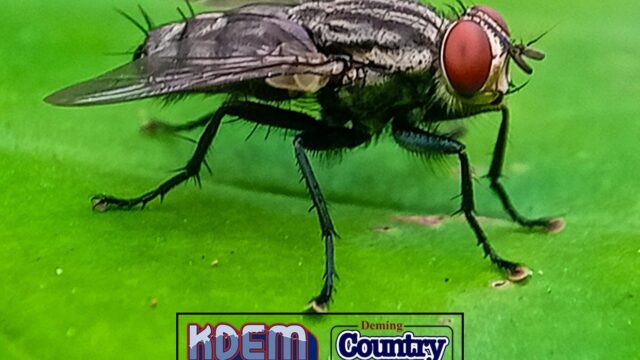DEMING – Local officials and state experts are working to raise awareness about the New World Screwworm, a parasitic insect that can cause serious harm to both humans and animals. Luna County Extension Agent Jack Blandford told Deming Radio News that the Extension Service and the New Mexico State Extension Service will host an informational meeting on Monday, August 18th at 6 p.m. at the Mimbres Valley Learning Center, 2300 East Pine Street.
New Mexico State Extension Veterinarian Dr. John Wendzel will lead the meeting, providing information on awareness, prevention, and treatment of the screwworm. The public is encouraged to attend, as the fly and its destructive larvae have recently been detected in Mexico, about 350 miles from the U.S.–Mexico border.
What Is the New World Screwworm?
The New World screwworm (Cochliomyia hominivorax) is a parasitic fly whose larvae can infest living tissue—a condition called traumatic myiasis. Unlike typical maggots that feed on dead flesh, these larvae burrow into open wounds on livestock, pets, wildlife, and occasionally humans, consuming healthy tissue and causing severe pain, infection, and in untreated cases, even death.
Female flies lay 250–500 eggs at a time in wounds or natural body openings. Eggs hatch within 12 to 21 hours, and the larvae immediately begin feeding in a spiral pattern, which gives the “screwworm” its name. After about a week of feeding, the larvae drop to the ground to pupate and eventually emerge as adult flies.
Historically, the screwworm was once widespread across the southern U.S., Mexico, and Central America. Thanks to a large‑scale eradication effort using the Sterile Insect Technique—releasing sterilized male flies—the parasite was eradicated from the U.S. by the mid‑1960s and from Mexico by 1991. However, the screwworm remains endemic in parts of South America, Central America, and the Caribbean, which is why ongoing monitoring is crucial.
Why the Public Should Care
Infection can occur in livestock, pets, and humans. For pet owners and ranchers, prevention is critical because screwworm females are attracted to fresh wounds. Infection can progress quickly, resulting in deep tissue damage, secondary infections, and expensive veterinary or medical intervention.
Authorities note that outbreaks in northern Mexico highlight the potential for the pest to spread northward if vigilance decreases. The U.S. Department of Agriculture (USDA) continues to operate surveillance and sterile fly release programs to prevent reinfestation.
Prevention Tips for Humans and Animals
- Immediate Wound Care
- Clean any cut, scratch, or wound promptly with running water and mild soap.
- Dry the area and cover it with a clean, breathable bandage.
- This reduces odors and moisture that attract screwworm flies.
- Pet and Livestock Protection
- Inspect animals regularly for wounds, surgical sites, and ear or eye irritation.
- Clean and bandage any wounds promptly.
- In endemic areas, veterinarians recommend topical insecticides or repellents to protect healing wounds.
- Environmental Control
- Reduce fly populations by properly disposing of garbage and animal waste.
- Limit exposure of animals with open wounds to outdoor areas where flies are active.
- Early Action
- If you ever observe maggots in a wound on a human or pet, seek immediate medical or veterinary care.
- Quick removal and treatment can prevent tissue loss and stop the life cycle of the screwworm.
Public Meeting Details
Luna County residents are invited to learn more and ask questions at the upcoming New World Screwworm Informational Meeting:
- Date: Monday, August 18, 2025
- Time: 6:00 p.m.
- Location: Mimbres Valley Learning Center, 2300 East Pine Street, Deming
- Hosted by: Luna County Extension Service & New Mexico State Extension Service
- Speaker: NM State Extension Veterinarian Dr. John Wendzel
- Topic: Awareness, prevention, and treatment of New World Screwworm
Blandford emphasizes that community awareness is the first line of defense. “Even though the screwworm isn’t currently in the U.S., it is close enough that we need to remain vigilant,” he said.
Sources:
Information for this story was gathered from an on‑air interview with Luna County Extension Agent Jack Blandford on Deming Radio News; public outreach materials from the New Mexico State University Extension Service; the U.S. Department of Agriculture (USDA); the World Organisation for Animal Health (WOAH); the American Veterinary Medical Association (AVMA); the MSD Veterinary Manual; and supporting reference articles from Wikipedia, Wired, and BMC Genomics.




